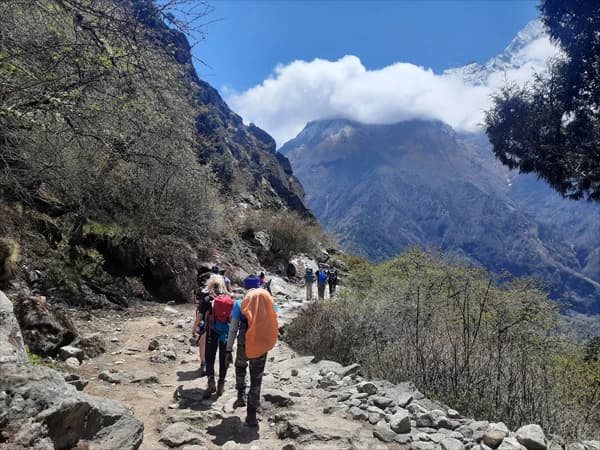The Annapurna Circuit is one of the most renowned and rewarding trekking routes in Nepal, attracting adventurers from around the world. From the bustling tea houses to the serene Annapurna Base Camp, the journey offers trekkers a chance to experience the incredible beauty of the Annapurna Range, including the towering Annapurna II, Annapurna South, and even the majestic Mt. Annapurna itself. Whether you're seeking the challenge of crossing the Thorong La Pass or simply want to witness the mountain views, the Annapurna Circuit Trek is a worthwhile trip for anyone with a love for nature, adventure, and cultural exploration.
A Trek Through Stunning Views and Spectacular Adventures: Annapurna hike Circuit
Exploring the Annapurna Circuit Trek
The Annapurna Circuit trek offers some of the most stunning views of the Himalayas. As trekkers make their way along the mountain trail, they are greeted with breathtaking sights at every corner, including the Annapurna Sanctuary and the deep valleys surrounding it. The trek begins at Pokhara and gradually ascends through various landscapes, from subtropical forests to rugged mountain terrain.
For those tackling the circuit, one of the highlights is the Thorong La and the highest point of the trek. Thorong La Pass, located at 5,416 meters, offers incredible views of the surrounding snow-capped peaks, making it a real reward for those with mental strength to push through the dusty road and dirt road sections that lead up to it. On the way, you will also encounter Yak Kharka, a picturesque location known for its yak herders and rustic tea houses that dot the landscape.
Beautiful Villages of Annapurna
The Annapurna Circuit also offers trekkers an authentic glimpse into the daily lives of local communities. As you pass through villages like Manang and Dhampus Peak, you'll find vibrant local cultures and fascinating insights into the traditions of the Annapurna region. Manang village, nestled in the heart of the Annapurna district, serves as a popular stop for acclimatization during trekking. It offers a chance to rest, explore the village, and enjoy local delicacies such as garlic soup, which is believed to help with altitude sickness.
Gangapurna Lake, near Manang, is another picturesque spot on the trek, offering wonderful sights and a peaceful atmosphere for trekkers to relax and enjoy. The trail also takes you through the Nar Phu Valley, one of the most remote trails of the region, providing an opportunity to disconnect from the modern world and connect with nature.
Annapurna Base Camp Trek: A Must-Do Adventure
The Annapurna Base Camp Trek is a popular trek that leads you into the heart of the Annapurna Sanctuary. This trek provides some of the best mountain views in the world, with panoramic views of the Annapurna Range, Annapurna IV, and the majestic Annapurna South. It’s a favorite for those who want to immerse themselves in the beauty of the mountains and witness the untouched grandeur of Nepal's highest peaks.
Along the way, trekkers can rest at cozy trekking lodges or tea houses, where they can enjoy warm meals like fresh fruit or even chocolate bars to recharge for the day ahead. Be sure to bring trekking poles, trekking trousers, and thermal layers to stay comfortable while walking along the rugged trails. And don't forget essential trekking gear like water purification tablets or a reusable water bottle, as drinking water along the route can be unreliable, and plastic bottles are often not allowed in many parts of the trek.
Crossing the Famous Thorong La Pass
For many trekkers, crossing Thorong La High Pass is the pinnacle of the Annapurna Circuit. It requires a solid level of fitness and mental strength, as it’s a challenging section with significant altitude gain. After passing Thorong Phedi, trekkers ascend through Thorong La High Camp, where they may experience the thin mountain air. But the reward is worth it and reaching the summit of the pass and gazing upon the stunning high-altitude views is an unforgettable experience.
From here, trekkers descend to the valley, and the trek heads towards Tilicho Lake, known for its high-altitude beauty and serenity. Lake Tilicho is considered one of the highest lakes in the world, surrounded by pine forests and terraced farmlands.
Helpful Tips for Trekking the Annapurna Circuit
When planning your trek, there are several things to keep in mind to make your journey more enjoyable and comfortable. The trek cost will vary depending on whether you choose a private trek or go with public transport. If you prefer a more comfortable experience, you may choose private transport to the trailheads for an additional cost.
During your trek, remember that it's important to take rest days for acclimatization at key locations like Manang and Thorong Phedi to avoid altitude sickness. The trek’s Trek time is typically around 12-15 days, but some trekkers opt to take longer, giving them plenty of time to enjoy the sights and culture along the way.
Another consideration is the trekking season and crowded time on the trail is usually during the spring and autumn months, so if you prefer a quieter experience, consider trekking during the shoulder seasons. Regardless of when you go, be sure to bring necessary supplies like toilet paper, bottled water, and hot water from the tea houses to stay comfortable throughout the journey.
Exploring the Annapurna Sanctuary and Beyond
While the Annapurna Circuit is already famous for its majestic views and rich cultural experiences, there are many other incredible trekking routes in the region, such as the Annapurna Sanctuary Route and the Phu Valley. These trails offer trekkers the chance to explore even more remote areas, such as the Tukuche Peak and Ice Lake, which boast incredible trekking routes and breathtaking landscapes.
From the highest points of the Thorong La Pass to the serene waters of Gangapurna Lake, the Annapurna Circuit offers a wonderful trip for anyone looking to push their limits and immerse themselves in the beauty of Nepal’s mountains.
FAQs:
-
What is the best time to trek the Annapurna Circuit?
The best time to trek the Annapurna Circuit is during the spring (March to May) and autumn (September to November) seasons. These months offer clear skies, pleasant temperatures, and fewer chances of rain. - How long does it take to complete the Annapurna Circuit Trek?
The Annapurna Circuit Trek typically takes 12-15 days, depending on the pace and acclimatization days. Some trekkers choose to extend their journey to explore additional areas such as Tilicho Lake. - Do I need a guide for the Annapurna Circuit Trek?
While it’s not mandatory, having an expert assistant guide is highly recommended, especially for safety and to gain cultural insights along the way. You can also opt for a private trek with additional assistance from the Discovery World Trekking team. - What should I bring on the Annapurna Circuit Trek?
Essential items include trekking poles, trekking trousers, thermal layers, water purification tablets, reusable water bottles, toilet paper, and hot water from tea houses. Ensure you also carry your personal snacks, like chocolate bars or fresh fruit. - Is the Annapurna Circuit Trek suitable for beginners?
The trek is suitable for trekkers with a moderate level of fitness. It’s important to allow time for acclimatization to avoid altitude sickness. For beginners, it’s advisable to take your time and follow a guided trek to ensure a safer experience. - What is the altitude of Thorong La Pass?
Thorong La Pass is the highest point on the Annapurna Circuit Trek, located at 5,416 meters (17,769 feet) above sea level. It offers spectacular views of the surrounding mountains and valleys. - Are there accommodations along the Annapurna Circuit?
Yes, trekkers can stay in tea houses and trekking lodges along the trail. These accommodations offer basic amenities, warm meals, and a place to rest after a long day’s trek. Hot water and bottled water are often available, though some trekkers prefer to bring their own reusable water bottles for convenience. - How much does it cost to trek the Annapurna Circuit?
The cost varies depending on factors like the trek’s duration, whether you choose private transport or public transport, and if you hire a guide or porter. Expect an additional cost for private services and extra accommodations during the trek. - What kind of food can I expect during the trek?
You’ll find a range of food options along the Annapurna Circuit, including garlic soup, dal bhat (lentil soup with rice), fried rice, and fresh fruit. Tea houses often serve simple meals that help replenish energy for the next leg of the trek. - How can I stay hydrated on the Annapurna Circuit?
While bottled water is available, many trekkers opt for water purification tablets or carry reusable water bottles to reduce waste. Tap water can be unsafe, so make sure to treat it before drinking or buy water at designated stops.
Conclusion
Whether you're trekking for the challenge of crossing Thorong La or simply looking for spectacular views of the Annapurna Range, the Annapurna Circuit Trek offers an unforgettable adventure through some of Nepal's most remarkable landscapes. From the high-altitude views to the warmth of the tea houses, this trek will leave you with lasting memories and a greater appreciation for the beauty and culture of the Annapurna region. With the guidance of an expert assistant guide and the support of the Discovery World Trekking team, your journey will be well-supported every step of the way.



